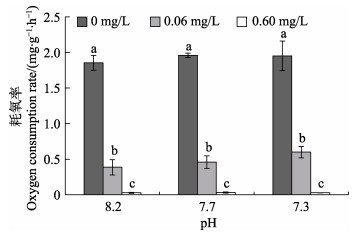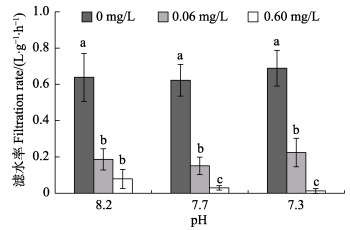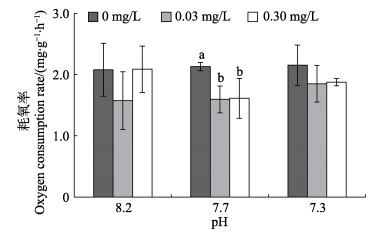2. 中国水产科学研究院黄海水产研究所 农业农村部海洋渔业可持续发展重点实验室 山东省渔业资源与生态环境重点实验室 山东 青岛 266071;
3. 青岛海洋科学与技术试点国家实验室海洋生态与环境科学功能实验室 山东 青岛 266237
2. Yellow Sea Fisheries Research Institute, Chinese Academy of Fishery Sciences, Key Laboratory of Sustainable Development of Marine Fisheries, Ministry of Agriculture and Rural Affairs, Shandong Provincial Key Laboratory of Fishery Resources and Eco-Environment, Qingdao, Shandong 266071, China;
3. Laboratory for Marine Ecology and Environmental Science, Pilot National Laboratory for Marine Science and Technology (Qingdao), Qingdao, Shandong 266237, China
随着经济的高速发展,工业生产,如有色金属冶炼、煤炭燃烧和电子垃圾处理等产生的重金属通过地表径流等方式大量输入近海,并在输送过程中不断沉积,成为沿海海域的主要污染物(Zarykhta et al, 2019; Zhang et al, 2017)。我国近海河口环境Cu污染水平在过去几十年中呈逐渐上升趋势(潘科等, 2014; 宋永刚等, 2016),以渤海西北岸的锦州湾海域为例,其沉积物中Cu和Cd的浓度最高分别可达1072和1463 mg/kg,海水中浓度则分别为1.7~3.5和1.7~2.0 μg/L(Pan et al, 2012)。2002年10月,江苏省如东洋口出现文蛤(Meretrix meretrix)大面积死亡现象,死亡文蛤体内检出极高的Cd、Pb和Zn含量(詹文毅等, 2003)。中国北方的典型半封闭式海湾——胶州湾河口沉积物中Cu和Cd浓度分别为600和27 mg/kg,受到重金属污染的巨大压力(Deng et al, 2010)。由此可见,重金属污染已威胁到近岸滩涂贝类养殖产业的健康发展。
菲律宾蛤仔(Ruditapes philippinarum)是中国沿海滩涂常见的经济贝类,栖息于近岸泥沙底质区域的浅表层,该区域受人类活动的影响极其显著,其栖息地的pH和盐度等较外海变化大且复杂(刘鹏飞, 2016)。Riba等(2004)研究显示,pH值降低可增加沉积物中重金属的迁移率,导致已稳定在沉积物中的重金属,如Cu、Cd、Zn和Pb的二次释放。在海洋酸化(ocean acidification, OA)日趋加剧的背景下(李晓梅等, 2016),研究重金属在不同pH条件下对滩涂贝类的生理胁迫具有重要的生态意义和经济意义。
近年来,国内关于重金属与酸化复合胁迫对贝类生理影响的研究有较大进展,但大多集中于牡蛎和魁蚶(Scapharca broughtonii)等(曹瑞文, 2019; 李阳, 2018; 李晓梅等, 2016),针对菲律宾蛤仔的研究较少。本文研究了不同pH条件下(8.2、7.7和7.3),重金属Cu和Cd对蛤仔生理的影响,除了选取耗氧率(OR)和滤水率(FR) 2个重要生理指标外,连续监测了蛤仔心率的变化,以获取实时、直观和连续的观测结果,旨在研究海洋酸化背景下重金属对滩涂贝类生理的影响,为面临全球气候变化与重金属污染等多重压力的海水养殖提供参考,同时探讨心率在水生生物实验中作为生理指标的优缺点。
1 材料与方法 1.1 实验材料以普通海水(pH 8.2)作为对照组,配制2种酸化海水(pH 7.7和7.3),并选取了重金属Cu和Cd进行实验。Cu和Cd各设置3个浓度,分别为0、0.06、0.60 mg/L和0、0.03、0.30 mg/L,浓度设置参考李阳(2018)对魁蚶的研究。2种酸化海水设置分别参照政府间气候变化专门委员会(IPCC)对2100年和2300年海水表面pH的预测(Caldeira et al, 2005)。
菲律宾蛤仔取自胶州湾海域,选取外壳完整、健康且大小一致[(32.07±1.39) mm]的个体,于60.0 cm× 40.0 cm×30.0 cm的聚乙烯水槽内暂养7 d。暂养过程中,保持连续充气,每24 h换水1次,每天投喂球等鞭金藻(Isochrysis galbana)(4×104 cells/mL) 2次。实验前1 d停止投喂。
实验在国家贝类产业技术中心(山东威海)进行,海水取自爱伦湾海域(37°9′N,122°33′E),盐度为32.0±1.0,pH为8.17±0.02,经沉淀、砂滤后备用。实验前2 h,使用CO2气瓶配制酸化海水,分别调节pH至7.7和7.3,只充干燥空气的海水作为对照组(C),实测pH及水体初始溶解氧(DO)见表 1。酸化组海水DO与对照组差异不显著(P > 0.05),不会影响蛤仔正常呼吸。用CuSO4和CdCl2 (分析纯,国药集团化学试剂有限公司)分别配制0.5 mg/mL的Cu和Cd溶液作为母液,实验时按浓度要求进行稀释。实验过程中保持(22.0±0.5)℃恒定室温。
|
|
表 1 实验海水pH、重金属浓度和菲律宾蛤仔规格 Tab.1 Seawater pH, concentration of heavy metals, and biological characteristics of R. philippinarum |
使用四通道光纤测氧仪(OXY-4 mini,德国)测定DO,数据由电脑软件Precens记录。呼吸瓶为250 mL广口瓶,瓶盖预先钻小孔连接氧探针及温度探针,用以连续监测水体温度及DO。每个呼吸瓶放置3个蛤仔,每组4个重复,另设空白对照,待蛤仔均伸出水管后计时,实验时间为0.5~1 h。实验结束后,测量蛤仔规格及软组织干质量。使用Excel以DO和实验时间t (h)作图,并线性拟合得到函数y=kt+a,OR计算公式为,
| $ {\rm{OR}}=-k·V/W $ |
式中,OR为单位体重耗氧率[mg/(g·h)],k为拟合直线斜率,W为干质量(g),V为呼吸瓶体积(L)。
1.2.2 滤水率测定实验在500 mL烧杯中进行,海水中放入一定数量的球等鞭金藻,浓度控制在30×104~50×104 cells/mL,保持微充气使金藻混合均匀。每个实验容器放置3个蛤仔,每组4个重复,另设空白对照,实验时间为0.5~1 h。使用血球计数板镜检法分别测定实验前后海水中球等鞭金藻的浓度,将蛤仔软体部剖出,60℃烘至恒重,称重。滤水率参考杜美荣等(2009)的方法计算。
1.2.3 心率测定参考林思恒等(2016)测定鲍鱼心率的非损伤性方法,使用蓝丁胶(Blu-Tack, Bostik Ltd, 英国)将红外传感器固定在蛤仔心脏对应的壳表面,心跳产生的光电流经信号放大器(AMP 03, heartbeat monitor, Newshift, 葡萄牙)放大过滤处理后,由数据采集(DAQ)设备(Powerlab 8/30, AD Instruments, 德国)记录,利用软件LabChart V8.0可计算出心率(bpm)。根据耗氧率和滤水率的实验结果,选取影响较明显但未过度降低蛤仔活力的0.06 mg/L Cu、0.30 mg/L Cd和pH 7.3进行心率测定,以普通海水作为对照组(C)。随机选取菲律宾蛤仔16个,连接传感器并在普通海水中暂养至心率稳定(蛤仔活跃且15 min内心率无明显波动视为心率稳定),之后分别转移至实验用海水中,每组4个蛤仔。记录蛤仔心率变化,持续时间约为0.5 h。
利用软件SPSS 19.0分析比较不同海水pH条件下Cu和Cd对菲律宾蛤仔OR、FR和心率的影响,以P < 0.05作为显著性差异的检验标准。
2 结果 2.1 菲律宾蛤仔在不同胁迫条件下的耗氧率和滤水率实验期间对照组(普通海水)菲律宾蛤仔OR为(1.86±0.10) mg/(g·h),FR为(0.64±0.13) L/(g·h),差异均不显著(P > 0.05)(图 1和图 2)。单因素方差分析(one-way ANOVA)显示,Cu对蛤仔的OR和FR均有显著影响(P < 0.05)。与对照组相比,菲律宾蛤仔在含有Cu的海水中活动明显减少,且出现进出水管回缩及闭壳现象。在含0.60 mg/L Cu的海水中(包括酸化及未酸化海水),蛤仔的OR和FR均趋近于0。pH对蛤仔OR和FR无显著影响(P > 0.05),但在Cu为0.06 mg/L时,随着pH的下降,OR略有上升(P > 0.05)。双因素方差分析(two-way ANOVA)结果显示(表 2),pH和Cu胁迫对蛤仔OR和FR无交互作用(P > 0.05)。

|
图 1 不同酸化和Cu处理下菲律宾蛤仔的耗氧率变化 Fig.1 Variation of oxygen consumption rate of clams at different acidification and Cu treatments 不同字母表示差异显著(P < 0.05)。下同 Different letters represent significant differences (P < 0.05). The same as below |

|
图 2 不同酸化和Cu处理下菲律宾蛤仔的滤水率变化 Fig.2 Variation of filtration rate of clams at different acidification and Cu treatments |
|
|
表 2 蛤仔耗氧率和滤水率在酸化和重金属胁迫条件下的双因素方差分析 Tab.2 Two-way ANOVA of the OR and FR of calm under acidification and heavy metal addition |
与Cu不同,蛤仔在含Cd的海水中无明显异常,水管喷水活跃,状态与对照组基本相同。pH 8.2与pH 7.3处理组中Cd对OR影响不显著(P > 0.05),但随着Cd浓度的升高,OR有下降趋势(图 3)。当海水pH为7.7时,Cd处理组的蛤仔OR显著低于无Cd海水中蛤仔的OR (P < 0.05)。Cd对菲律宾蛤仔的FR影响不显著(P > 0.05)(图 4)。双因素方差分析结果显示,pH和Cd胁迫对蛤仔OR和FR没有交互作用(P > 0.05)(表 2)。

|
图 3 不同酸化和Cd处理下菲律宾蛤仔的耗氧率变化 Fig.3 Variation of oxygen consumption rate of clams at different acidification and Cd treatments |

|
图 4 不同酸化和Cd处理下菲律宾蛤仔的滤水率变化 Fig.4 Variation of filtration rate of clams at different acidification and Cd treatments 不同实验组间未发现显著差异(P > 0.05) No significant difference was found among all treatments (P > 0.05) |
在心率测定中,每组有3~4个个体获得有效心率测定结果,取平均值进行对比(图 5),并选取5个时间点(0、5、6、11和20 min),比较各实验组蛤仔心率的差异(表 3)。蛤仔初始心率均值为(24.2±4.7) bpm,差异不显著(P > 0.05),随着时间的变化,各组心率呈现不同的变化趋势。Cd处理组(0.30 mg/L Cd,pH 8.2)蛤仔的心率在0~15 min时明显上升,15 min后心率逐渐稳定,20 min时蛤仔心率(39.0 bpm)相比初始值(26.0 bpm)上升了50%。Cu处理组(0.06 mg/L Cu,pH 8.2)蛤仔的心率在0~10 min时明显下降,10 min后逐渐稳定,20 min时蛤仔心率[(10.6±0.3) bpm]约为初始值的45%。酸化组中(pH=7.3),蛤仔的心率呈先下降后缓慢回升的趋势,并在20 min时恢复至(20.5± 4.3) bpm,与初始心率无显著差异(P > 0.05)。

|
图 5 Cu、Cd或酸化处理下菲律宾蛤仔的心率变化 Fig.5 Variation of heart rate of clams at Cu, Cd or acidification treatments |
|
|
表 3 相同处理时间各实验组菲律宾蛤仔的心率 Tab.3 Heart rate of clams at the same incubation time among different treatments |
Cu是机体必不可少的金属元素,在软体动物中参与形成各种金属酶结构,但当机体过度摄入Cu时则会产生毒性(Arumugam et al, 2020; Bartlett et al, 2020; Pan et al, 2009)。Ivanina等(2015)使用与当地环境水平相近的Cu和Cd浓度(0.05 mg/L)进行了7 d的暴露实验,发现美洲牡蛎(Crassostrea virginica)和美洲帘蛤(Mercenaria mercenaria)的组织能够很好地抵御金属诱导的氧化应激,且对于Cu有更好的处理能力。而在本研究中,0.06 mg/L的Cu即对蛤仔生理产生显著影响。由此可见,重金属对海洋双壳类的影响具有物种特异性,且与暴露时间有关。李阳等(2018)也证明了这一点,Cu胁迫显著降低魁蚶耗氧率、排氨率和氧氮比,且降低程度与暴露时间和浓度有关;经0.1 mg/L Cu暴露96 h后,魁蚶鳃丝出现尖端膨大、排列散乱以及细胞溶出等现象。Grace等(1987)研究表明,Cu可导致鳃中丝间隔断裂,但不影响与生物体分离后的鳃纤毛的摆动,其对侧纤毛的抑制是一种神经元机制。因此,Cu降低滤水率可能是神经抑制以及鳃丝分离共同作用的结果。
国内外关于Cd对双壳贝类的急性毒性及生物蓄积相关研究较多,但缺乏详细的生理代谢数据(Rattikansukha et al, 2019; 陈海刚等, 2008)。本研究中,Cd胁迫对菲律宾蛤仔的耗氧率和滤水率的影响小于Cu胁迫,这可能是由于低浓度Cd暴露引起了蛤仔体内防御机制的启动,诱导了金属螯合剂,如金属硫蛋白(MTs)和铁蛋白的表达上调(徐彦等, 2013),在一定程度上消除了Cd的毒性,因此,耗氧率和滤水率没有显著变化。Blasco等(1999)的研究也表明,Cd对双壳类天门冬氨酸氨基转移酶(AST)的毒性小于Cu。Shi等(2016)研究发现,在长期海水酸化与Cd (0.05 mg/L)复合胁迫实验中,低pH环境(7.8和7.4)会促进Cd在双壳类鳃、外套膜和闭壳肌中的积累,这可能是本研究中酸化与Cd复合胁迫下蛤仔耗氧率下降的原因,而由于实验时间较短,不同pH导致的下降程度并不一致。
高山等(2017)研究发现,青蛤(Cyclina sinensis)在酸化环境下培养10 d后耗氧率显著降低,死亡率与酸化时间正相关,而本研究仅针对短期酸化进行了分析,这可能是pH对蛤仔耗氧率和滤水率无显著影响的原因,同时,导致pH与Cu/Cd没有显著交互作用。另外,沿海滩涂环境由于陆地径流和潮汐的影响,pH波动较大,菲律宾蛤仔作为典型的潮间带生物,可能已建立了短期酸化处理下的应激适应机制,这也是短期酸化对蛤仔影响较小的原因之一。
3.2 菲律宾蛤仔在不同胁迫条件下的心率双壳类的心脏是肌源性的,心脏神经或内脏神经节的刺激可能影响心脏搏动,Cu或Cd可以象影响侧纤毛一样通过神经通路影响心率(Grace et al, 1987)。需要注意的是,实验中各项生理指标的降低总是伴随着蛤仔的闭壳行为。Davenport等(1984)研究指出,心跳过缓是心脏瓣膜关闭导致的,贻贝可以探测到环境中的Cu并相应地关闭贝壳,或不改变贝壳开放程度而改变泵送速率,这可能是Cu导致蛤仔心率下降的原因之一。Ivanina等(2015)研究指出,暴露于0.05 mg/L Cd可导致双壳类血细胞胞内H+ (pHi)浓度下降30%~50%,而0.05 mg/L Cu对pHi无影响。Anwer等(1993)对哺乳动物的研究发现,Cd可以通过刺激Na+/H+交换器和干扰胞内Ca2+信号(模拟Ca2+流入细胞)干扰细胞代谢、信号传导和离子运输。本研究中,0.30 mg/L Cd可能通过干扰蛤仔体内的信号传导,刺激了心脏神经,并最终导致蛤仔心跳过速。
海水pH骤降到7.3,蛤仔心率先下降后迅速恢复正常的原因如前所述,可能与蛤仔对短期酸化的应激适应有关。Ivanina等(2015)研究也表明,海水pCO2及pH的改变对双壳类血细胞的pHi和酸碱稳态无显著影响,这也是酸化海水下蛤仔心率较为稳定的原因。通过红外线信号方法测定心率具有非损伤性、可进行原位测定的优点,且得到的指标可以精准量化(林思恒等, 2016),已在皱纹盘鲍(Haliotis discus hannai)和贻贝(Braby et al, 2006)等无脊椎动物中得到应用。本研究中,相比耗氧率和滤水率等常规指标,心率监测反映了蛤仔受到胁迫后的即时反应,在较短的时间内即可显示出差别,适合作为短期实验的指标。由于其无损伤性的特点,也可用于珍稀贝类的实验。但同时,心率测定也存在其劣势。实验选用的蛤仔个体较小,且外壳有一定弧度,红外探头需通过蓝丁胶紧密贴合在心脏处的壳表面,实际操作过程中有可能出现蛤仔心率曲线缺失现象,未来需进一步优化探头连接。
本研究仅涉及了pH与重金属的短期胁迫,未来可进一步探讨长期酸化条件下pH与重金属的复合效应。目前,尚未找到pH影响重金属对双壳类毒性的有力证据,但pH变化对污染河口的金属动力学和迁移影响已有较多研究证实(Hyland et al, 1999; Mount et al, 1992; Schubauer-Berigan et al, 1993)。目前,养殖业面临的压力更多来自河口及沿海地区的重金属污染,未来应对养殖用水以及底质环境严格规范以保障食品安全。
致谢: 感谢中国科学院海洋研究所实验海洋生物学重点实验室为心率测定提供仪器协助,感谢林思恒在仪器使用和心率测定过程中提供的指导和建议。感谢中国农业大学林琳在实验过程中给予的帮助与支持。
ANWER K, OBERTI C, PEREZ G J, et al. Calcium-activated K+ channels as modulators of human myometrial contractile activity. American Journal of Physiology, 1993, 265(4): C976-C985 DOI:10.1152/ajpcell.1993.265.4.C976 |
ARUMUGAM A, LI J, KRISHNAMURTHY P, et al. Investigation of toxic elements in Carassius gibelio and Sinanodonta woodiana and its health risk to humans. Environmental Science and Pollution Research, 2020, 27(16): 19955-19969 DOI:10.1007/s11356-020-08554-1 |
BARTLETT J, MAHER W, UBRIHIEN R, et al. Fitness of two bivalves Saccostrea glomerata and Ostrea angasi exposed to a metal contamination gradient in Lake Macquarie, NSW Australia: Integrating subcellular, energy metabolism and embryo development responses. Ecological Indicators, 2020, 110(105869): 1-12 |
BLASCO J, PUPPO J. Effect of heavy metals (Cu, Cd and Pb) on aspartate and alanine aminotransferase in Ruditapes philippinarum (Mollusca: Bivalvia). Comparative Biochemistry and Physiology Part C: Pharmacology, Toxicology and Endocrinology, 1999, 122(2): 253-263 DOI:10.1016/S0742-8413(98)10116-0 |
BRABY C E, Somero G N. Following the heart: Temperature and salinity effects on heart rate in native and invasive species of blue mussels (genus Mytilus). Journal of Experimental Biology, 2006, 209(13): 2554-2566 DOI:10.1242/jeb.02259 |
CALDEIRA K, WICKETT M E. Ocean model predictions of chemistry changes from carbon dioxide emissions to the atmosphere and ocean. Journal of Geophysical Research, 2005, 110: C09S04 |
CAO R W. Combined toxic effects of seawater acidification and trace metals (Cd2+ and Cu2+) on economic shellfish. Doctoral Dissertation of University of Chinese Academy of Sciences (Yantai Institute of Costal Zone Research), 2019, 6-75 [曹瑞文. 海水酸化和痕量金属(Cd2+和Cu2+)对经济贝类的复合毒性效应研究. 中国科学院大学(烟台海岸带研究所)博士研究生学位论文, 2019, 6-75]
|
CHEN H G, LIN Q, CAI W G, et al. Comparisons on the accumulation and elimination characteristic of Hg, Pb and Cd in three kinds of marine bivalve molluscs. Journal of Agro-Environment Science, 2008, 27(3): 1163-1167 [陈海刚, 林钦, 蔡文贵, 等. 3种常见海洋贝类对重金属Hg, Pb和Cd的积累与释放特征比较. 农业环境科学学报, 2008, 27(3): 1163-1167 DOI:10.3321/j.issn:1672-2043.2008.03.056] |
DAVENPORT J, REDPATH K J. Copper and the mussel Mytilus edulis. In: BOLIS L, ZADUNAISKY J, GILLES R (eds). Toxins, drugs, and pollutants in marine animals. Proceedings in life sciences. Berlin, Heidelberg: Springer, 1984, 176-189
|
DENG B, ZHANG J, ZHANG G R, et al. Enhanced anthropogenic heavy metal dispersal from tidal disturbance in the Jiaozhou Bay, North China. Environmental Monitoring and Assessment, 2010, 161(1/2/3/4): 349-358 |
DU M R, FANG J G, GE C Y, et al. Effects of salinities and microalgae densities on filtration rates of scallop Chlamys farreri spats. Progress in Fishery Sciences, 2009, 30(3): 74-78 [杜美荣, 方建光, 葛长宇, 等. 盐度和饵料密度对栉孔扇贝稚贝滤水率的影响. 渔业科学进展, 2009, 30(3): 74-78 DOI:10.3969/j.issn.1000-7075.2009.03.013] |
GAO S, LIANG J, LI Y R, et al. Effect of ocean acidification on respiration rate and excretion rate in clam Cyclina sinensis. Fisheries Science, 2017, 36(6): 758-762 [高山, 梁健, 李永仁, 等. 海水酸化对青蛤耗氧率和排氨率的影响. 水产科学, 2017, 36(6): 758-762] |
GRACE A L, GAINEY Jr L F. The effects of copper on the heart rate and filtration rate of Mytilus edulis. Marine Pollution Bulletin, 1987, 18(2): 87-91 DOI:10.1016/0025-326X(87)90574-1 |
HYLAND J L, VAN DOLAH R F, SNOOTS T R. Predicting stress in benthic communities of southeastern U.S. estuaries in relation to chemical contamination of sediments. Environmental Toxicology and Chemistry, 1999, 18(11): 2557-2564 DOI:10.1002/etc.5620181124 |
IVANINA A V, HAWKINS C, BENIASH E, et al. Effects of environmental hypercapnia and metal (Cd and Cu) exposure on acid-base and metal homeostasis of marine bivalves. Comparative Biochemistry and Physiology Part C: Toxicology and Pharmacology, 2015, 174/175: 1-12 DOI:10.1016/j.cbpc.2015.05.001 |
LI X M, GUO T H, ZHANG L J, et al. Effects of ocean acidification on the toxicity of lead on lysozyme activity of Crassostrea rivularis. Jiangsu Agricultural Sciences, 2016, 44(12): 297-299 [李晓梅, 郭体环, 张来军, 等. 海洋酸化背景下铅胁迫对近江牡蛎溶菌酶活性的影响. 江苏农业科学, 2016, 44(12): 297-299] |
LI Y, XUE S Y, LI J Q, et al. Effect of Cu2+ stress on physiology biochemistry and histopathological structure of Scapharca broughtonii. Journal of Fisheries of China, 2018, 42(10): 1531-1540 [李阳, 薛素燕, 李加琦, 等. Cu2+胁迫对魁蚶生理生化和组织结构的影响. 水产学报, 2018, 42(10): 1531-1540] |
LI Y. Physiological response of ark shell Scapharca broughtonii to Cu2+ and ocean acidification stress. Masterxs Thesis of Shanghai Ocean University, 2018, 9-22 [李阳. 魁蚶Scapharca broughtonii对Cu2+和海水酸化胁迫的生理响应. 上海海洋大学硕士研究生学位论文, 2018, 9-22]
|
LIN S H, WU F C, ZHANG G F. Variation in cardiac response to thermal stress in two different cultured populations of Pacific abalones. Marine Sciences, 2016, 40(11): 84-90 [林思恒, 吴富村, 张国范. 高温胁迫下皱纹盘鲍不同养殖群体心率变化比较. 海洋科学, 2016, 40(11): 84-90 DOI:10.11759/hykx20160328003] |
LIU P F. Export flux of dissolved inorganic carbon from the Yangtze River and its effects on estuarine pH and CaCO3 saturation states. Masterxs Thesis of Shanghai Ocean University, 2016, 27-61 [刘鹏飞. 长江无机碳入海通量及其对河口pH和碳酸钙饱和度的影响. 上海海洋大学硕士研究生学位论文, 2016, 27-61]
|
MOUNT D R, MOUNTZ D I. A simple method of pH control for static and static-renewal aquatic toxicity tests. Environmental Toxicology and Chemistry, 1992, 11(5): 609-614 DOI:10.1002/etc.5620110504 |
PAN K, WANG W X. Biodynamics to explain the difference of copper body concentrations in five marine bivalve species. Environmental Science and Technology, 2009, 43(6): 2137-2143 DOI:10.1021/es802888u |
PAN K, WANG W X. Trace metal contamination in estuarine and coastal environments in China. Science of the Total Environment, 2012, 421-422: 3-16 DOI:10.1016/j.scitotenv.2011.03.013 |
PAN K, ZHU A J, XU Z B, et al. Copper contamination in coastal and estuarine waters of China. Asian Journal of Ecotoxicology, 2014, 9(4): 618-631 [潘科, 朱艾嘉, 徐志斌, 等. 中国近海和河口环境铜污染的状况. 生态毒理学报, 2014, 9(4): 618-631] |
RATTIKANSUKHA C, MILLWARD G E, LANGSTON W J. Partitioning of Cd, Zn and Fe in the tissues and cytosols of blood cockles (Anadara granosa) from the gulf of Thailand. Estuaries and Coasts, 2019, 42(1): 237-249 DOI:10.1007/s12237-018-0452-1 |
RIBA I, DELVALLS T Á, FORJA J M, et al. The influence of pH and salinity on the toxicity of heavy metals in sediment to the estuarine clam Ruditapes philippinarum. Environmental Toxicology and Chemistry, 2004, 23(5): 1100-1107 DOI:10.1897/023-601 |
SCHUBAUER-BERIGAN M K, DIERKES J R, MONSON P D, et al. pH-dependent toxicity of Cd, Cu, Ni, Pb and Zn to Ceriodaphnia dubia, Pimephales promelas, Hyalella azteca and Lumbriculus variegatus. Environmental Toxicology and Chemistry, 1993, 12(7): 1261-1266 DOI:10.1002/etc.5620120715 |
SHI W, ZHAO X, HAN Y, et al. Ocean acidification increases cadmium accumulation in marine bivalves: A potential threat to seafood safety. Scientific Reports, 2016, 6: 20197 DOI:10.1038/srep20197 |
SONG Y G, WU J H, SHAO Z W, et al. Evaluation of heavy metal pollution in the offshore surface seawater of the Liaodong Bay. Progress in Fishery Sciences, 2016, 37(3): 14-19 [宋永刚, 吴金浩, 邵泽伟, 等. 辽东湾近岸表层海水重金属污染分析与评价. 渔业科学进展, 2016, 37(3): 14-19] |
XU Y, WANG Y, ZHOU B, et al. Study on single and joint toxic effects of cadmium and lead on Ruditapes philippinarum. Marine Environmental Science, 2013, 32(1): 6-10 [徐彦, 王悠, 周斌, 等. Cd2+和Pb2+的单一和复合作用对菲律宾蛤仔的急性毒性效应研究. 海洋环境科学, 2013, 32(1): 6-10] |
ZARYKHTA V V, ZHANG Z H, KHOLODKEVICH S V, et al. Comprehensive assessments of ecological states of Songhua River using chemical analysis and bivalves as bioindicators. Environmental Science and Pollution Research, 2019, 26(32): 33341-33350 DOI:10.1007/s11356-019-06349-7 |
ZHAN W Y, WANG N P, YE H, et al. Study on the cause of death of Meretrix meretrix in large area in Rudong, Jiangsu. Marine Fisheries Research, 2003, 24(4): 62-65 [詹文毅, 王南平, 叶辉, 等. 江苏如东文蛤大面积死亡原因探究. 海洋水产研究, 2003, 24(4): 62-65] |
ZHANG P, HU R J, ZHU L H, et al. Distributions and contamination assessment of heavy metals in the surface sediments of western Laizhou Bay: Implications for the sources and influencing factors. Marine Pollution Bulletin, 2017, 119(1): 429-438 DOI:10.1016/j.marpolbul.2017.03.046 |



